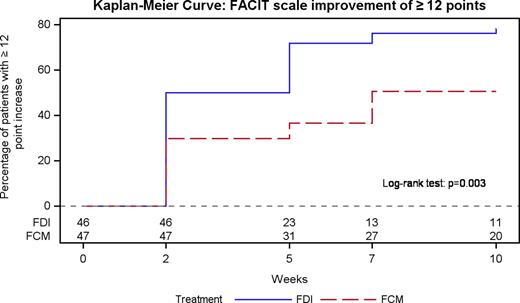Abstract

Introduction: Anemia is the most common extraintestinal complication of inflammatory bowel disease (IBD), and it is associated with reduced patient functional performance. Fatigue, the cardinal symptom of iron deficiency anemia (IDA), is reported by approximately 50% of IBD patients at the time of diagnosis and negatively impacts quality of life. Intravenous (IV) iron is often used in this population to treat IDA and alleviate fatigue symptoms. In this post hoc analysis of the PHOSPHARE-IBD trial, we explored the effects of ferric derisomaltose (FDI) vs. ferric carboxymaltose (FCM), two high-dose IV iron preparations, on fatigue as a patient-reported outcome.
Methods: PHOSPHARE-IBD was a randomized, double-blind, trial in adults with both IBD and IDA. The primary endpoint, incidence of hypophosphatemia, occurred in 8.3% of FDI-treated patients and in 51.0% of FCM-treated patients [adjusted risk difference: -42.8% (95% CI: -57.1, -24.6) p<0.0001]. Greater decreases in serum phosphate following IV iron treatment were associated with slower improvements in fatigue, reported as Functional Assessment of Chronic Illness Therapy (FACIT) Fatigue Scale. In this post-hoc analysis, we compared the ability of the two IV iron preparations to produce a 12-point increase in the FACIT scale, which has previously been reported to correlate with 'much better patient health' in the physician global assessment (PGA) of response to treatment scale in patients with IBD.
Results: Between May 2018 and May 2020, 97 patients were recruited in the trial; 48 received FDI and 49 received FCM. Increases in hemoglobin (Hb) were substantial and comparable between the two compounds. The proportion of patients achieving ≥ 12 points increase in the FACIT scale at any time point during the trial was 78.3% in the FDI arm and 48.9% in the FCM arm (p=0.005), while at Week 2 it was 51.1% vs. 29.8% (0.055), Week 5 68.9% vs. 27.3% (p<0.001), Week 7 69.8% vs. 41.9% (p=0.016) and Week 10 68.9% vs. 45.2% (p=0.031), respectively. In a time-to-event analysis, patients treated with FDI were significantly more likely than patients treated with FCM to achieve ≥ 12 points increase in the FACIT scale (Figure 1, p=0.003).
Conclusion: FDI was more effective in improving fatigue symptoms compared to FCM despite comparable improvements in Hb. This study provides additional evidence on the clinical consequences of IV iron-induced hypophosphatemia.
Disclosures
No relevant conflicts of interest to declare.
Author notes
 This icon denotes a clinically relevant abstract
This icon denotes a clinically relevant abstract
Asterisk with author names denotes non-ASH members.


